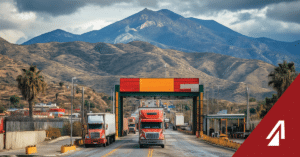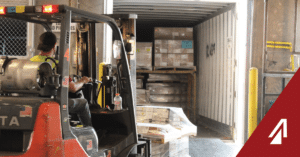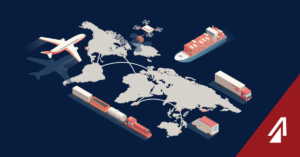It’s that time of year, where the world falls in love – with Christmas Trees. The holiday staple has nearly completed its harvest for this season and will soon be shipped across the globe – greatly increasing freight volume for the next six weeks. The large volume increase will affect regions in North Carolina, Pennsylvania, the Northern Midwest, and the Pacific Northwest, as well as raise the already high demand for drivers. With greater driver shortages on the horizon, what can shippers do to be prepared for Christmas tree season?
What is Christmas Tree Season?
Christmas tree season is an annual phenomenon, in the United States, beginning mid-November and going through late December. Shoppers purchase harvested live trees, most notably Douglas fir and Noble fir, as decoration for their homes and organizations to celebrate Christmas. According to the National Christmas Tree Association, tree farms sold nearly 28 million trees last year at an average price of $75 each – totalling nearly $2 billion dollars. These trees represent a legitimate crop, similar to cotton or soy beans, and a major U.S. business enterprise. The majority of the trees are grown in Oregon and North Carolina, and are shipped around the U.S. and overseas each year. Close to 26% of these trees are sold to big-box retail chains like Wal-Mart or The Home Depot and the rest are sold to nurseries, retail lots, non-profits, or choose-and-cut farms.
What Regions Will Be Affected?
Primarily, states like Oregon, Washington, North Carolina, Pennsylvania, Wisconsin and Michigan will be greatest affected. Oregon is the leading producer of Christmas trees and North Carolina is a close runner-up. However, the tree-industry is United States-wide. Farms will transport their trees to all 50 states, continental and contiguous, as well as the Caribbean Islands, Mexico, Canada, and Asia. Drivers will be sourced from all over the US to run these loads.
How Does This Season Affect Shippers in These Regions?
Shippers need to be prepared for a spike in load volume – especially in the highest tree growth areas. (Pacific Northwest and North Carolina) A typical 53 foot dry van can hold anywhere from 400-500 seven-foot tall trees, and fewer taller trees. With this year on par to match or exceed 2018’s 30 million tree sales, shippers can expect an increase of 54,000-60,000 loads in the next few weeks.
Christmas tree loads often cost more than other freight because the tree shipments are heavy, perishable, and have an immediate market demand. Not to mention, the trees often pick up and deliver in remote locations, far from higher freight-populated areas. Drivers will typically charge more for these dead-head miles to and from freight-friendly markets. Higher fuel prices are also a factor this year. The national average is currently at $3.282/mile compared to last year’s $2.746/mile according to AAA. Drivers who do not accept Christmas tree freight will often pass on their opportunity costs to shippers in other industries.
The low driver supply, and the high load demand are a perfect combination for the prices to skyrocket.
What Can Shippers Do to Be Prepared?
Shippers can do a few things to help with the upcoming shortages and higher prices.
Work with a trusted 3PL – Especially during the busier Christmas tree and holiday seasons. Fewer drivers are working today, and with higher load to driver ratios, shippers will need the dependability 3PLs provide. 3PLs have an extensive carrier network with both contracted and non-contracted carriers and can put drivers in place to meet shippers’ needs. These 3PLs can help with the spike in prices by having contracts with both shippers and carriers. These relationships help shippers save time and money instead of relying on high-priced spot-bidding rates. In addition, 3PLs offer other benefits like cutting edge technology for booking or tracking loads, risk management, and flexibility.
Get orders in early – The more time the better. The key to navigating the busy season is to plan ahead. Shippers will need to give their planning teams as much time as possible to find the best options for the loads. Loads do not necessarily need to ship earlier (although if that could be arranged it would help), but options need time to be put in place. Carriers need to plan schedules for their drivers to work, get home, and navigate government mandates. Carriers will help save shippers money if they have a chance to plan ahead and pair up profitable lanes.
Try and avoid last minute shipments – This goes hand in hand with planning ahead. Shippers should avoid last minute shipments if possible for several reasons to ensure they receive the best options. First, Christmas tree freight pays drivers very well and other shippers will be directly competing for drivers’ services. Shippers will have to be more competitive with rates or more flexible with their loads to win out. Next, last minute options are not always available. Drivers will either be too far away, or not want to drive to the desired destinations. Convincing drivers to take these loads can be very expensive. Lastly, drivers are aware when loads are last minute and will charge accordingly. Planning ahead and securing drivers earlier is easier and much more cost effective.
Be ready for drivers to run the loads – Shippers can avoid costly headaches by having the freight ready to ship at the time they schedule. Detention and other accessorial charges are expensive and will cost the shipper more than just the fees. Detaining drivers can cause disruption in their load plans, causing other lost opportunities. This will give the shippers a bad reputation and make it tougher to secure loads with them in the future.
The Christmas tree season can be a tough time for freight shippers. They compete with fewer drivers for more expensive loads in a time sensitive marketplace. Shippers can try and prepare for the peak season by planning their loads ahead of time, limiting last minute shipments, and being ready for drivers when they come to pick up loads. The best thing shippers can do is work with a trusted 3PL to help them find the best options to meet their needs.


